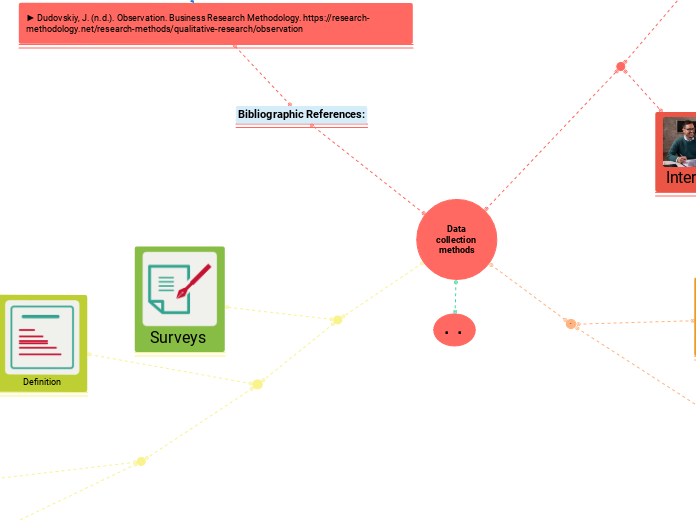przez JENNIFER PAMELA LANDAZURI LLUMIQUINGA 2 lat temu
278
Data collection methods

przez JENNIFER PAMELA LANDAZURI LLUMIQUINGA 2 lat temu
278

Więcej takich
A survey is defined as brief interviews and discussions with individuals about a specific topic.
It aims to determine insights about a group of people.
A survey is the process of collecting, analysing and interpreting data from many individuals.
Charactics
Types
Surveys use online or offline forms
Replicable
if you apply the same methods more than once, you will achieve similar results.
Systematic
Survey research follows systematic procedures.
Usage
Surveys are used to gather information about human behavior.
Customized surveys can run the risk of containing certain types of errors
Surveys with closed-ended questions may have a lower validity rate than other question types.
Data errors due to question non-responses may exist.
Respondents may not feel comfortable providing answers that present themselves in a unfavorable manner.
Respondents may not feel encouraged to provide accurate, honest answers.
Strenghs
Can be administered remotely via online, mobile devices, mail, email, kiosk, or telephone.
Cost-effective, but cost depends on survey mode
Can be developed in less time (compared to other data-collection methods)
Relatively easy to administer
Characterisitics
-Can be divided into overt or covert categories.
- Observation could use writing field notes, making entries into a log, or keeping a journal. Audiotapes and videotapes checklists, and rating scales.
The researcher also participates with individuals in their activities in participant observation.
Observation as a data collection method can be structured or unstructured.
- Observation may be associated with certain ethical issues.
- Represents a longer time requirements, high levels of observer bias, and impact of observer on primary data,
- Includes direct access to research phenomena, high levels of flexibility in terms of application and generating a permanent record of phenomena to be referred to later.
- The interviews give to the researcher the chance to do it face-to-face or via web
- The interview is a meeting between and interviewer and an interviewee.
.
Characteristics
To show interest and confidentiality with the information gathered.
It is possible to include interviewee's feelings, and experiences.
Have in mind the objective of the interview all along it.
It has to have a clear topic.
Challenges
Analysis of qualitative data from unstructured interviews can also be time-consuming.
The presence of the interviewer may influence the respondent's answers.
Can be costly, especially if they require trained interviewers.
Can take a long time.
Strengths
In the case of unstructured interviews, they are:
Allows questions to be adapted according to respondents' answers.
More flexible.
In the case of structured interviews, they are:
Useful for reliability testing.
Easy to reproduce and quantify.
Generate qualitative data through the use of open-ended questions.
Clarify responses in real time.
Ability to collect detailed information.